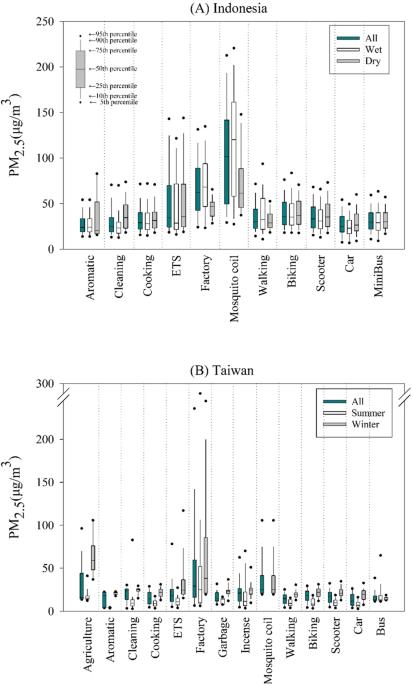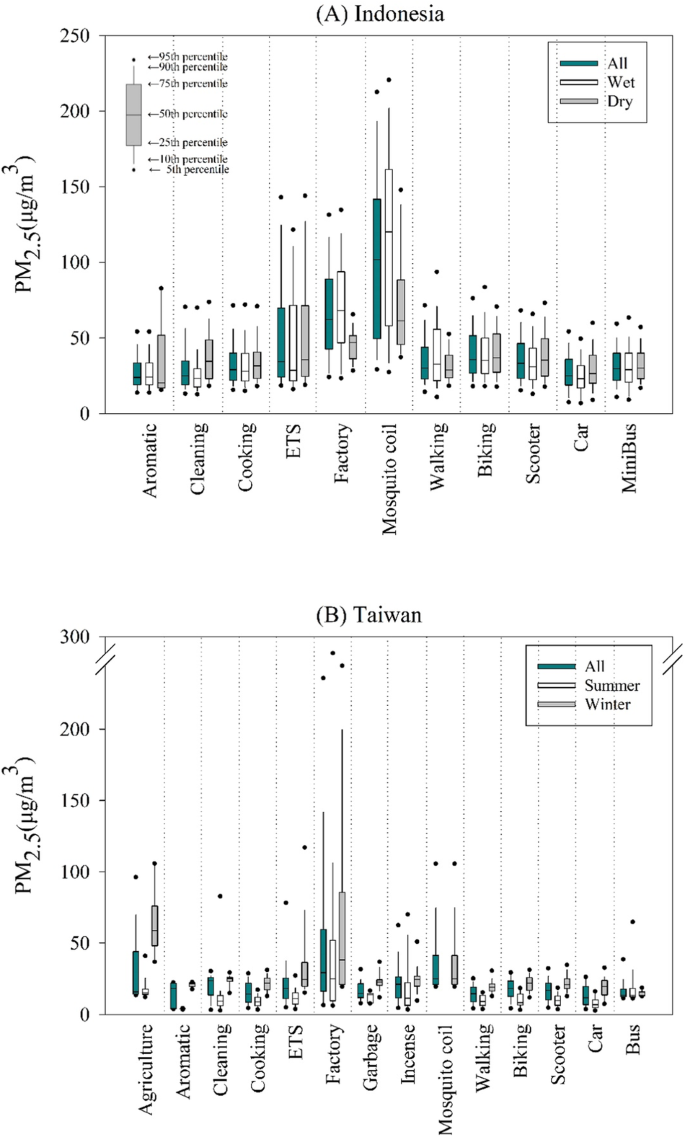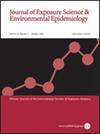印度尼西亚和台湾使用微型传感器测量 PM2.5 和 PM1 暴露的峰值、来源和对健康的直接影响。
IF 4.7
3区 医学
Q2 ENVIRONMENTAL SCIENCES
Journal of Exposure Science and Environmental Epidemiology
Pub Date : 2024-05-28
DOI:10.1038/s41370-024-00689-4
引用次数: 0
摘要
背景:微传感器已被用于高分辨率颗粒物(PM)监测:微传感器已被用于高分辨率颗粒物(PM)监测:本研究应用 PM 和健康微传感器,旨在评估两个亚洲国家 PM2.5 和 PM1 的峰值暴露、来源和对健康的直接影响:方法:2018 年和 2019 年在印度尼西亚万隆对 50 名受试者进行了暴露评估和健康评价,2019 年和 2020 年在台湾高雄对 55 名受试者进行了暴露评估和健康评价。分别使用校准过的 AS-LUNG 装置和经过医疗认证的 RootiRx® 传感器来评估 PM 和心率变异性(HRV):总体而言,印度尼西亚的 PM2.5 和 PM1 5 分钟平均暴露量分别为 30.4 ± 20.0 和 27.0 ± 15.7 µg/m3 ,台湾分别为 14.9 ± 11.2 和 13.9 ± 9.8 µg/m3 。在印度尼西亚,PM2.5 和 PM1 的最大 5 分钟峰值分别为 473.6 和 154.0 µg/m3 ,在台湾分别为 467.4 和 217.7 µg/m3。社区工厂和蚊香燃烧是两个最重要的暴露源,与非暴露期相比,印尼受试者的PM2.5暴露量平均分别增加了4.73和5.82微克/立方米,台湾受试者的PM2.5暴露量平均分别增加了10.1和9.82微克/立方米。此外,农业废料焚烧和焚香也是另两个重要的暴露源,但仅限于台湾。此外,根据广义加法混合模型,5 分钟 PM2.5 和 PM1 暴露对台湾所有受试者和印度尼西亚滑板车受试者的心率变异指数和心率有显著的直接影响。PM2.5和PM1每增加10微克/立方米,心率变异指数的变化从-0.9%到-2.5%不等,但低频-高频比率除外,在这两个国家,PM1比PM2.5的影响更大:这项研究强调了微型传感器捕捉PM2.5和PM1高峰值的能力,通过整合活动记录确定暴露源,以及评估印度尼西亚和台湾约50名受试者心率变异性的即时变化。这项研究是为数不多的能证明峰值 PM 对健康的直接影响的研究之一,是对大多数流行病学研究中评估的短期(数天或数周)或长期(数月或更长)影响的补充。所采用的技术/方法为 PM2.5 和 PM1 含量较高的资源有限国家的研究人员提供了巨大的潜力。本文章由计算机程序翻译,如有差异,请以英文原文为准。


Peaks, sources, and immediate health impacts of PM2.5 and PM1 exposure in Indonesia and Taiwan with microsensors
Microsensors have been used for the high-resolution particulate matter (PM) monitoring. This study applies PM and health microsensors with the objective of assessing the peak exposure, sources, and immediate health impacts of PM2.5 and PM1 in two Asian countries. Exposure assessment and health evaluation were carried out for 50 subjects in 2018 and 2019 in Bandung, Indonesia and for 55 subjects in 2019 and 2020 in Kaohsiung, Taiwan. Calibrated AS-LUNG sets and medical-certified RootiRx® sensors were used to assess PM and heart-rate variability (HRV), respectively. Overall, the 5-min mean exposure of PM2.5 and PM1 was 30.4 ± 20.0 and 27.0 ± 15.7 µg/m3 in Indonesia and 14.9 ± 11.2 and 13.9 ± 9.8 µg/m3 in Taiwan, respectively. The maximum 5-min peak PM2.5 and PM1 exposures were 473.6 and 154.0 µg/m3 in Indonesia and 467.4 and 217.7 µg/m3 in Taiwan, respectively. Community factories and mosquito coil burning are the two most important exposure sources, resulting in, on average, 4.73 and 5.82 µg/m3 higher PM2.5 exposure increments for Indonesian subjects and 10.1 and 9.82 µg/m3 higher PM2.5 exposure for Taiwanese subjects compared to non-exposure periods, respectively. Moreover, agricultural waste burning and incense burning were another two important exposure sources, but only in Taiwan. Furthermore, 5-min PM2.5 and PM1 exposure had statistically significantly immediate impacts on the HRV indices and heart rates of all subjects in Taiwan and the scooter subjects in Indonesia with generalized additive mixed models. The HRV change for a 10 µg/m3 increase in PM2.5 and PM1 ranged from −0.9% to −2.5% except for ratio of low-high frequency, with greater impacts associated with PM1 than PM2.5 in both countries. This work highlights the ability of microsensors to capture high peaks of PM2.5 and PM1, to identify exposure sources through the integration of activity records, and to assess immediate changes in heart rate variability for a panel of approximately 50 subjects in Indonesia and Taiwan. This study stands out as one of the few to demonstrate the immediate health impacts of peak PM, complementing to the short-term (days or weeks) or long-term effects (months or longer) assessed in most epidemiological studies. The technology/methodology employed offer great potential for researchers in the resource-limited countries with high PM2.5 and PM1 levels.
求助全文
通过发布文献求助,成功后即可免费获取论文全文。
去求助
来源期刊
CiteScore
8.90
自引率
6.70%
发文量
93
审稿时长
3 months
期刊介绍:
Journal of Exposure Science and Environmental Epidemiology (JESEE) aims to be the premier and authoritative source of information on advances in exposure science for professionals in a wide range of environmental and public health disciplines.
JESEE publishes original peer-reviewed research presenting significant advances in exposure science and exposure analysis, including development and application of the latest technologies for measuring exposures, and innovative computational approaches for translating novel data streams to characterize and predict exposures. The types of papers published in the research section of JESEE are original research articles, translation studies, and correspondence. Reported results should further understanding of the relationship between environmental exposure and human health, describe evaluated novel exposure science tools, or demonstrate potential of exposure science to enable decisions and actions that promote and protect human health.

 求助内容:
求助内容: 应助结果提醒方式:
应助结果提醒方式:


